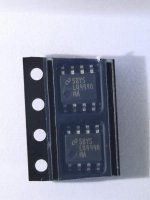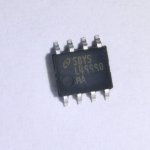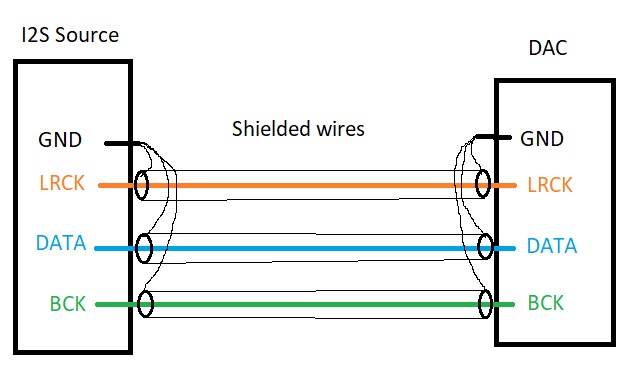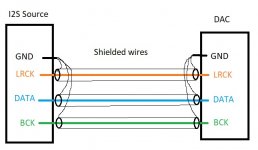LME49990
So this came from poland already transplanted to DAC. According to pictures posted by Miro I wouldn't bet this are original since the hole looks flat/ish (on pictures from Miro you can clearly see hemispherical hole on mine it is realy hard to tell) ... Sound wise they work They sound good what I noticed is the bass is not so heavy and it is more natural than ADA4627-1. Will replace again with ADA4627-1 in a couple of days and see.
They sound good what I noticed is the bass is not so heavy and it is more natural than ADA4627-1. Will replace again with ADA4627-1 in a couple of days and see.


So this came from poland already transplanted to DAC. According to pictures posted by Miro I wouldn't bet this are original since the hole looks flat/ish (on pictures from Miro you can clearly see hemispherical hole on mine it is realy hard to tell) ... Sound wise they work


...
1. will it better Sound Quality if using PCM output from JLsound card without 6 onboard shift registers?
2. will it better Sound Quality if using isolator to provide I2S signal between pi2 and AD1862 DAC to skip the USB signal transmission?
...
1. Comparison with a bad routed PCB (without the solid GND, crossed signal lines) the improvement can be noticed. Probably not on this PCB.
2. Isolator is useless in case of asynchronous data transfer (most xmos based are asynchronous). I tested isolator with PCM2706/7 (synchronous) and it didn't help at all (in R-2R), I'd rather say the sound got worse. In case of a FIFO reclocks - these will help with delta-sigma, not in NOS R-2R.
On the other hand, a subjective impression or belief can help
Can You Trust Your Ears? (Audio Illusions) - YouTube
yup, but they could be genuine as well : if the hole is elleptcal enough it could be from a different plant and manufactering tool generation... I don't see chineese children in a cave rounding elleptical holes on oaps the night at the candle light to make few cents for the owner for him to buy a pangolin for christmass or some camels for the silk road to send his oaps in Poland!
Swap it with a 5532, if it sounding the same, you know that it is a fake rebadged, now if it is near enough of some ADA or LM of good quality it's maybe not a fake ! Or Send it to Miro in order he can test it
Anyway, we see that swapping oap is just a part of a whole... there is th eimportance of the design with the drawing of the pc, the powersupplies topology, the passive parts, the choice of their values and types, etc...
One has to experiment a little
So some choice seems to make consensus... The LM, the 861, the 1656....
Swap it with a 5532, if it sounding the same, you know that it is a fake rebadged, now if it is near enough of some ADA or LM of good quality it's maybe not a fake ! Or Send it to Miro in order he can test it
Anyway, we see that swapping oap is just a part of a whole... there is th eimportance of the design with the drawing of the pc, the powersupplies topology, the passive parts, the choice of their values and types, etc...
One has to experiment a little
So some choice seems to make consensus... The LM, the 861, the 1656....
Last edited:
I m listenning to 1656 and it is very good, live sound. Very clean i like it a lot.yup, but they could be genuine as well : if the hole is elleptcal enough it could be from a different plant and manufactering tool generation... I don't see chineese children in a cave rounding elleptical holes on oaps the night at the candle light to make few cents for the owner for him to buy a pangolin for christmass or some camels for the silk road to send his oaps in Poland!
Swap it with a 5532, if it sounding the same, you know that it is a fake rebadged, now if it is near enough of some ADA or LM of good quality it's maybe not a fake ! Or Send it to Miro in order he can test it
Anyway, we see that swapping oap is just a part of a whole... there is th eimportance of the design with the drawing of the pc, the powersupplies topology, the passive parts, the choice of their values and types, etc...
One has to experiment a little
So some choice seems to make consensus... The LM, the 861, the 1656....
I have some jlsounds boards. Right now i dont have the shift resisters on ad1862 pcb, but in the next pcb i will put them and try to compare the two options.
JosephK, your ak4499 dac is good cause the decoupling layout with acrylics and the 1656 ! (I'm almost sure about that, say 80% I bet !)
Swap it with a ak4493 or 97 and I'm sure one can not hear the difference as the noise floor is so low ad the technology close enough with the dac chip ! (well I haven't purchase the dac from the japoneese guy as I'm a little short on monney for my hobby these days).
The 1656 is a good take
Swap it with a ak4493 or 97 and I'm sure one can not hear the difference as the noise floor is so low ad the technology close enough with the dac chip ! (well I haven't purchase the dac from the japoneese guy as I'm a little short on monney for my hobby these days).
The 1656 is a good take
I have a very good dac with 4490, the Mirand V1. 1, heavily modified. It is very much up to the task, indeed.
It has Sonny's discrete opamps as diff/se summing in output.
It does sound different (ly good..) and given that both my dacs with AK4499 are having a similar signature, I think much of it 'moves' with the dac chip..

It has Sonny's discrete opamps as diff/se summing in output.
It does sound different (ly good..) and given that both my dacs with AK4499 are having a similar signature, I think much of it 'moves' with the dac chip..
Hi Robin,
I have a souped up four board DDDAC with valve output stage which is very, very good. I'd expect to beat that with this design, passive i/v and valve output stage and that's what I'm building. I think you'll find as you are, that the op amp is one of the keym limiters in this implementation. I'll report back when I've got my chips and completed the build.
David
Please do! Looking forward to hearing your experiences.
What makes you think that this setup will beat the dddac?
For the "Miro" (if I may baptise mine[emoji16]) I have some passive I/V resistors (100r and 200r). What I could try is to add wayne linestage after this as a gain stage?
Today's listening session was very good, no fatigue whatsoever.
Please do! Looking forward to hearing your experiences.
What makes you think that this setup will beat the dddac?
For the "Miro" (if I may baptise mine[emoji16]) I have some passive I/V resistors (100r and 200r). What I could try is to add wayne linestage after this as a gain stage?
Today's listening session was very good, no fatigue whatsoever.
I built a DAC with AD1865 with tube output stage which was 'better' than the DDAC using a DIYHK board which I don't believe is as good as this one, and I reckon the AD1862 is 'better' than the 1865. One issue with the DDDAC is its quantisation noise, which means you have less apparent dynamic range
Still enjoying the DAC in the evenings! Got me wondering, how should I best deal with high res files from qobuz via my rpi with moode installed. I set mood to generic i2s dac with no resampling. 24/96khz files play but 24/pp192khz heavily distort. Should I set the moode client to always resample to 16bit?
@Robin De Wolf
24b/192kHz audio should work with this DAC (from that 20 most significant bits will be played). You can test it with an xmos based USB-I2S.
... the DAC logic does support a 64-bit frame I2S ... it does not support shorter bit frames (48 (2x24), 32 (2x16)) ... this 64-bit frame will transfer all stereo music files in resolutions 16-bit, 24-bit and 32-bit (from that 20-bit will be played)
... the question is: Does the RPI support 64-bit frame on 192kHz? RPi 4 should support it, but the older ones may be limited.
... I googled, that RPi 3 does support 24b/192kHz as the maximum, and here I don't know if it sends these bits in a 48-bit frame or can handle the 64-bit frame. If 16b/192kHz is played on the DAC, they are sent in the 64-bit frame, the same for 24/96khz (because it worked), but what is the frame for 24b/192kHz? (I found, that HDMI works only in 16b/192kHz) ...
Try to shorten the I2S wires. Or use a shielded wire for the I2S (but it probably won't be the solution )
)

24b/192kHz audio should work with this DAC (from that 20 most significant bits will be played). You can test it with an xmos based USB-I2S.
... the DAC logic does support a 64-bit frame I2S ... it does not support shorter bit frames (48 (2x24), 32 (2x16)) ... this 64-bit frame will transfer all stereo music files in resolutions 16-bit, 24-bit and 32-bit (from that 20-bit will be played)
... the question is: Does the RPI support 64-bit frame on 192kHz? RPi 4 should support it, but the older ones may be limited.
... I googled, that RPi 3 does support 24b/192kHz as the maximum, and here I don't know if it sends these bits in a 48-bit frame or can handle the 64-bit frame. If 16b/192kHz is played on the DAC, they are sent in the 64-bit frame, the same for 24/96khz (because it worked), but what is the frame for 24b/192kHz? (I found, that HDMI works only in 16b/192kHz) ...
Try to shorten the I2S wires. Or use a shielded wire for the I2S (but it probably won't be the solution
Attachments
Last edited:
- Home
- Source & Line
- Digital Line Level
- DAC AD1862: Almost THT, I2S input, NOS, R-2R

